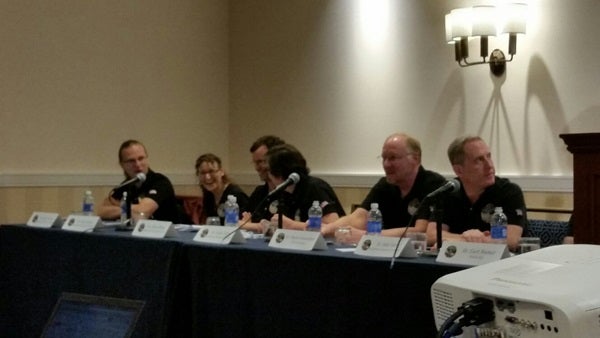During the five days of the 46th annual meeting of the Division for Planetary Sciences, being held this week in National Harbor, Maryland, researchers will deliver talks and present papers about objects across the solar system. Yet on day one, it was almost all Pluto, all the time. For the first time, members of the New Horizons team presented their findings about the distant world and its family of moons to the broader scientific community. Here are just a few highlights from the first day.
New Horizons team member Oliver White of NASA’s Ames Research Center delivered a bombshell: Pluto appears to have shield volcanoes, with broad bases, gentle slopes, and summit depressions (though no signs of ongoing eruptions). The features, informally named Piccard Mons and Wright Mons, rise 3.5 miles and 2 miles above the surrounding terrain, respectively. Of course, volcanoes on Pluto would be so-called cryovolcanoes, which erupt a slurry of melted ices and not molten rock. The outer solar system contains no other known shield volcanoes — the closest reside on Earth’s neighbor, Mars.
Above Pluto’s surface lies an atmosphere totally unlike the one scientists expected. Leslie Young of the Southwest Research Institute reported on observations that show it is significantly colder and more compact than predicted, and little of it is escaping into space. Before New Horizons, team members thought that this blanket of nitrogen, which originates as nitrogen ice on the surface turning directly to gas, leaked into space at a rate that would have eroded away about a half-mile of the surface over the age of the solar system. The new escape rate places the loss at closer to a half-foot.
The small moons orbiting Pluto also present a host of new mysteries. First, all of them rotate faster than they revolve around the planet (most of the solar system’s inner moons rotate and revolve around their planet at the same rate). Hydra leads the way, completing 89 rotations for each revolution. Also, Nix now rotates about 10 percent faster than it did just three years ago. And both Hydra and Kerberos appear to be objects formed from the long-ago merger of two separate bodies — much like the comet 67P/Churyumov-Gerasimenko, which is currently under scrutiny by the European Space Agency’s Rosetta spacecraft. New Horizons team member Mark Showalter of the SETI Institute summed up the wacky satellite system when he said that they “disobey our notions of how planetary moons ought to behave.”
Finally, Southwest Research Institute scientist Alex Parker discussed the craters on Pluto. Each of these impact features formed when a small Kuiper Belt object (KBO) smashed into the planet. The more than 1,000 craters give scientists better statistics on the size distribution of KBOs than all of the known objects in the Kuiper Belt. The crater counts imply that KBOs formed relatively large (at tens of miles across) and not small as some researchers thought. This implies that the KBO cataloged as 2014 MU69, the next target on New Horizons itinerary if NASA approves an extended mission, should be a primordial object. Scientists would love to get a close look at one of these pristine solar system building blocks.










